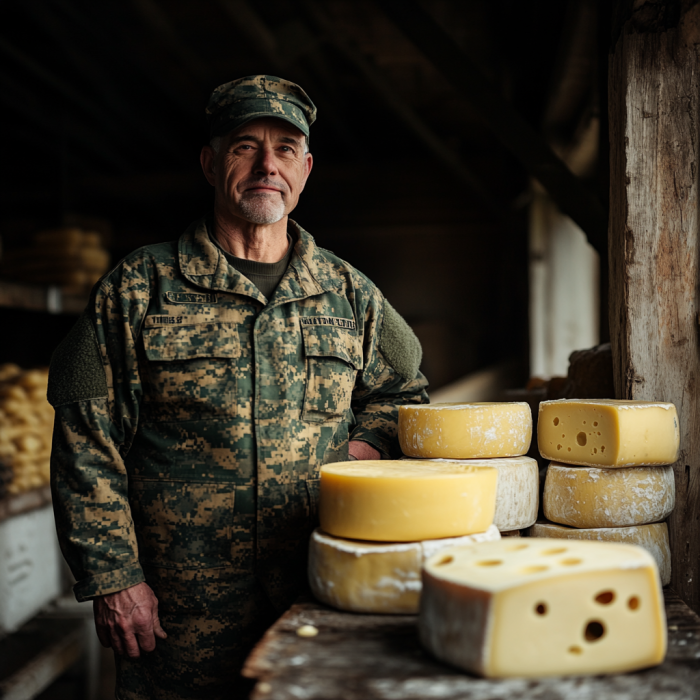How Are Veterans Contributing to American Cheesemaking?
NOVEMBER 11, 2024

Historically, cheesemaking has been deeply influenced by political and military upheavals. One poignant anecdote involves the Roman legions, whose far-reaching campaigns facilitated the introduction and adaptation of cheesemaking techniques across Europe. A prime example is Pecorino Romano, a hard, salty cheese that was a staple in the Roman diet, aiding soldiers' nutritional needs during long campaigns.
Fast forward to post-World War II, and we see another significant migration of military personnel into agricultural and food industries, including cheesemaking. The GI Bill enabled returning veterans to pursue education in agriculture and food sciences, laying the foundation for modern dairy techniques. This wave of veterans brought structured training and innovative practices to the cheesemaking process, which were critical in an era that sought efficiency without sacrificing quality.
Today's veteran cheesemakers bring with them stories of resilience and dedication. Their contributions reflect a confluence of traditional craftsmanship and modern scientific approaches. As they embrace dairy science, these veterans also revive historical cheesemaking traditions, ensuring that the rich tapestry of American cheese continues to evolve.
Consider a modern veteran-turned-cheesemaker like many who have ventured into the dairy industry. Their journeys from disciplined military service to meticulous cheese production illustrate the adaptability and precision carried over from their time in the service.
These veterans’ unique perspectives enhance American cheesemaking in several ways. Firstly, they maintain a commitment to quality and excellence derived from their military training. Secondly, their disciplined approach to problem-solving enables them to innovate, often integrating sophisticated technologies into traditional methods. Thirdly, their diverse backgrounds enrich the cultural fabric of the American cheesemaking community, introducing new varieties and techniques derived from global influences encountered during their service.
As we delve into the specifics of dairy science, it is crucial to acknowledge the evolution of cheese varieties shaped by historical events. For instance, Cheddar’s evolution from an English staple to an American favorite involved numerous adaptations—each epoch of conflict and peace contributing to its development. American veterans in cheesemaking are thus not just preserving a tradition but actively participating in its ongoing narrative.
The influence of historical events on cheese is evident when we examine the trajectory of cheeses like Parmigiano-Reggiano, which saw alterations in production methods during war times due to resource scarcity. Similar adaptations are seen in veteran cheesemakers today, who bring resourcefulness and innovation to their craft, often born out of necessity in their previous military roles.
Moreover, the cultural significance of cheese in various societies underscores the importance of these veterans' contributions. Cheese has long been a symbol of community and sustenance, from communal cheese festivals in medieval Europe to its role in American holiday spreads. Veterans, with their profound sense of community and service, are especially suited to this tradition, fostering environments where cheese serves as a medium for connection and heritage.
In conclusion, the integration of veterans into American cheesemaking reflects a storied tradition of innovation and resilience. By blending historical cheesemaking techniques with modern dairy science, these individuals not only preserve the past but also sculpt the future of American cheese. Their journeys from battlefields to dairy fields serve as poignant reminders of the rich, interconnected histories that shape our culinary landscapes.
More in History
November 11, 2024
How Are Veterans Contributing to American Cheesemaking?
October 29, 2024
How has Halloween Influenced Cheese Throughout History?
June 03, 2024
What Makes Florette Cheese a Modern Culinary Marvel?
May 20, 2024
How Did Smoked Gouda Cheese Become a Culinary Staple?
May 17, 2024
How Has Memorial Day Influenced the Evolution of Cheese?
March 09, 2024
Did St. Patrick's Day Traditionally Feature Green Cheese?
March 07, 2024
How Easter Traditions Shaped Cheese-Making History
February 29, 2024
Discovering the Essence of Smoked Gouda: A Journey Through Time